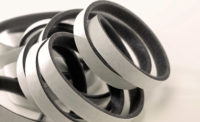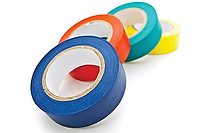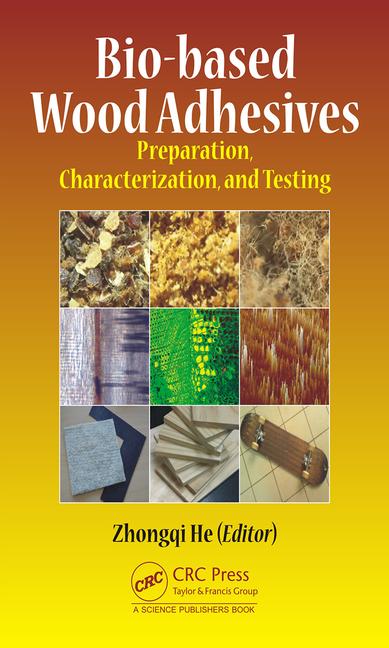Pressure-Sensitive Adhesive Testing
Testing pressure-sensitive adhesives under standard conditions of temperature and relative humidity is always a preferred means to compare data from lab to lab and from lot to lot, but it is sometimes necessary to evaluate the performance of an adhesive under conditions that it would encounter in the field.

Many adhesives exhibit different properties when subjected to variations in temperature. Some of these adhesives are thermoplastic. They soften when heated and become more brittle when cooled. [In the case of pressure-sensitive adhesives (PSAs), the nature of the bond is nearly always thermoplastic.] If for the sake of this discussion we limit our testing to tack, peel, and shear, we can develop a series of observations that can be applied to most testing situations.
In terms of the relative effect of temperature on the common PSA properties of tack, peel, and shear resistance, as the temperature increases, the adhesive mass softens and “wets” the substrate more rapidly and completely, and the tack and peel properties increase. At some point, however, the adhesive softens to the point that its cohesive strength is less than the substrate adhesion, and the adhesive mass splits, failing cohesively. As the temperature continues to increase, the adhesive mass continues to soften, and the tack and peel values continue to go down.
In testing shear resistance, one always looks for cohesive failure. As the temperature increases, shear resistance goes down as the adhesive mass softens. This reduction in shear resistance will be fairly slow and steady, to the point where the mass is so soft that it will not support a load for any appreciable time.
Chemsultants was involved in the round-robin testing of the ASTM committees that rewrote the shear and loop-tack test methods. A ranking of environmental conditions was developed to determine which aspects of the tests required first-order control. Temperature was ranked either first or second in all exercises. The viscoelastic behavior of polymer blends is a function of the temperature at which the measurement is taken. This logically extends to the simpler tests we run in the laboratory.
It is for these reasons that most standard test methods specify a standard test temperature (and humidity). Unless otherwise specified, the testing temperature should be kept at a standard 72ºF (±2º). Humidity, too, can play a role in performance and should be maintained at a level of 50% (±5%). Test samples should be stored at these conditions for at least 24 hours in order to achieve equilibrium.
Widening the Temperature Range
Pressure-sensitive applications have been expanded to include a wider range of temperatures, ranging now from -40°F to 250°F for conventional adhesives and higher for silicones. For example, airline baggage tag labels need to perform in low and high temperatures, often within a time span of a few hours. Some tapes targeted for the construction or automotive markets will need to perform at even higher temperature extremes. As a result, it is now essential that adhesives be evaluated for performance over a wider temperature range. When this is done, it is important to recognize the difference between application temperature and end-use temperature.
Application temperature is that temperature at which the adhesive is applied to a surface and is expected to achieve a bond. Generally, application is limited on the low end of the temperature scale. End-use temperature is that temperature at which the adhesive must perform adequately once the bond is made. The limitation in end-use temperature is usually at the high end of the temperature range.
One way to test the application temperature is to place the test samples and substrates at the selected temperature and allow them to equilibrate. Lamination is accomplished at this temperature, and the laminated samples are allowed to reside for a specific period, after which they are peeled at that temperature.
End-use temperature can be determined by making the lamination at room temperature and allowing the bond to build for a given time at this temperature. After this residence period, the samples are placed at the test temperature for a period of time to achieve equilibrium, and then they are peeled at that temperature. This measures the temperature sensitivity of a bond that was established and developed at a standard “assembly” temperature. The test temperature can be higher or lower than the assembly temperature.
Another way of looking at these same tests is to look at the way we apply the temperature differences. The most common is end-use testing and the selection of a standard temperature as a reference point for the test protocol.
These test temperatures are achieved by using an environmental chamber on the tester in the case of larger testing units. They also can be achieved by placing the testing unit in the testing environment, either a freezer or an oven.
Measuring PSA Shear Resistance
Several tests have been developed over the years to measure the shear resistance of PSAs. The standard is the PSTC/FINAT/ASTM shear test. This test uses a standard test surface at a one-degree angle at room temperature.
Shear Adhesion Failure Temperature (SAFT)
A modification of the shear-resistance test is the shear adhesion failure test, which is a modification of ASTM D-4498 — a standard test method for the heat-fail temperature in shear of hot-melt adhesives. As described in this method, the samples are assembled as in the shear test using a 500-gram load and placed into the test chamber. The temperature of the chamber starts at ambient and is ramped upward at a prescribed rate (60°F per hour is typical). The temperature at which the adhesive layer fails is noted as the shear adhesion failure temperature (SAFT) and serves as a guide to the high-temperature performance of the adhesive. It is important to be able to determine as accurately as possible the temperature of the adhesive layer, rather than the air temperature, since the adhering components (test sample and test surface) will take some time to achieve the temperature of the air in the chamber.
Tack Testing
Tack testing at different temperatures is also very important in predicting performance in certain applications. High-speed application of labels to refrigerated or frozen foods requires high tack at the application temperature. One method of measuring tack at lower temperatures is to use the probe-tack method and cool the probe by circulating cooled liquid through it. A less-cumbersome technique is to use the loop-tack method and place the tester in a cooled environment. It is very important to store the samples, substrates and tester in this environment for some time to achieve temperature equilibrium.
Accelerated Aging
Most manufacturers and users of pressure-sensitive adhesives ask for a two-year shelf life on the laminate. It usually is impractical to run real-time aging in order to predict the performance of the product due to the pressures of getting the product to market. As a result, the industry tries to accelerate the aging process by aging the product at temperatures somewhat above ambient.
While there is no standard set of aging conditions, 70°C is commonly used. Most of the original PSA technology was based on rubber polymers, and 70°C aging was a standard aging temperature for rubber. Likewise, the one- and three-week aging periods are holdovers from the rubber industry.
While 70°C is a generally accepted aging temperature, other temperatures may be used, with the choice based on the temperature stability of the other components in the laminate.
Unapplied means that the samples are aged with the release liner in place, after which the liner is removed and the samples are applied to the test surface for the specified time before peeling. Unapplied aging will relate to the “shelf life” of the laminate prior to its end use.
Applied means that the samples are applied to the test surface and allowed to reside there for the aging period before they are peeled. Applied aging will relate to the use life of the product after it is bonded to a substrate.
Predicting Temperature Response
While adhesive performance at various temperatures can be determined by practical testing (as described in this article), there are analytical test methods that can be used to predict temperature performance of pressure-sensitive adhesives. The polymers used in pressure-sensitive adhesives will have a variety of glass transition temperatures (Tg). For a PSA to be effective, the formulated mass must have a Tg of 50°C - 70°C below the temperature at which the adhesive is to be used. At the same time, however, the Tg cannot be so low that the adhesive mass is so soft that it fails cohesively even at room temperature.
Analytical techniques that can be used to determine the Tg of the adhesive mass include differential scanning calorimetry (DSC), differential thermal analysis (DTA), and dynamic mechanical analysis (DMA). Of these, the most commonly used method is DMA. DMA will measure the bulk properties of the adhesive mass, which will include the base polymer and any additives in it. It does not take into consideration any interfacial relationships between the adhesive and the surfaces to which it is bonded.
DMA will determine the storage modulus (G’) and loss modulus (G”) of the adhesive mass by sweeping through a range of frequencies and temperatures. Dividing G” by G’ yields the property tan d. Plotting tan d versus temperature will result in peaks that relate to the Tg of the adhesive mass. The type of information developed by DMA and other thermal analytical techniques can be used to formulate adhesives that will perform well at ambient conditions and at temperature extremes.
As noted above, DMA measures only the bulk properties of the adhesive mass. Final testing must be in the form of practical evaluations of the adhesive formulation, the substrates to be used in the application and the temperature ranges to be seen in the application.
Summary
Testing pressure-sensitive adhesives under standard conditions of temperature and relative humidity is always a preferred means to compare data from lab to lab and from lot to lot. However, there are times when it is necessary to evaluate the performance of an adhesive under conditions that it would encounter in the field. Further, accelerated aging at elevated temperatures is required to determine the shelf life and use life of the adhesive. Choice of the proper test method and equipment is important when trying to determine these important properties.
Acknowledgement: The author wishes to acknowledge the assistance of ChemInstruments, Fairfield, Ohio, which manufactures the test equipment used in running the test methods described in this article.
For additional information, contact the author at Chemsultants International Inc., 9349 Hamilton Dr., Mentor, OH 44060; phone 440-352-0218; fax 440-352-8572; or e-mail chemnet@apk.net.
Looking for a reprint of this article?
From high-res PDFs to custom plaques, order your copy today!








